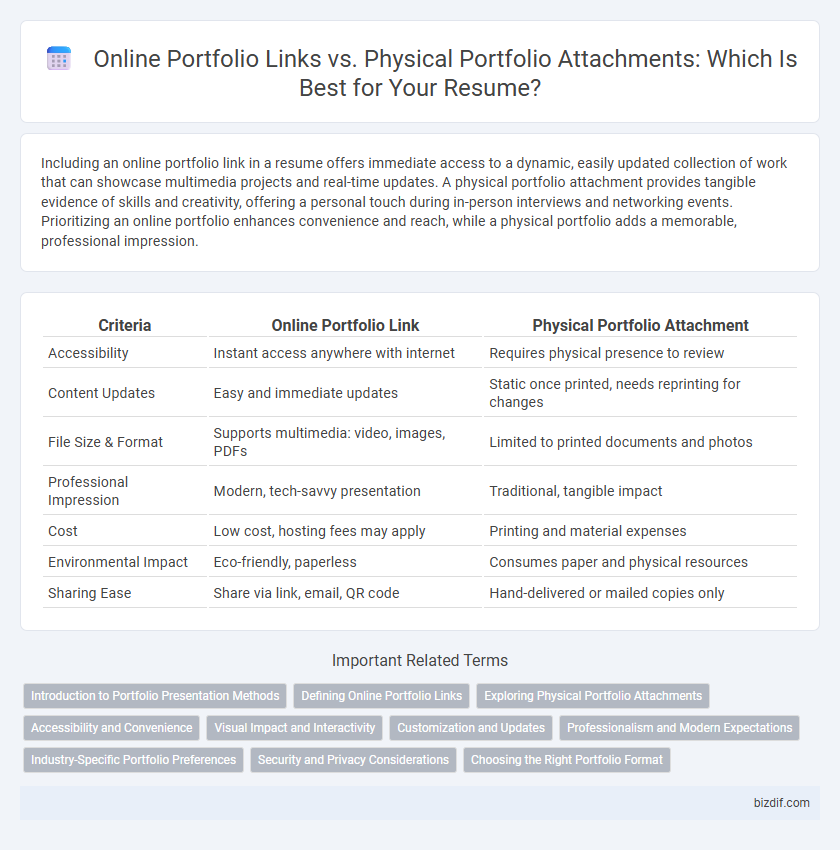Including an online portfolio link in a resume offers immediate access to a dynamic, easily updated collection of work that can showcase multimedia projects and real-time updates. A physical portfolio attachment provides tangible evidence of skills and creativity, offering a personal touch during in-person interviews and networking events. Prioritizing an online portfolio enhances convenience and reach, while a physical portfolio adds a memorable, professional impression.
Table of Comparison
| Criteria | Online Portfolio Link | Physical Portfolio Attachment |
|---|---|---|
| Accessibility | Instant access anywhere with internet | Requires physical presence to review |
| Content Updates | Easy and immediate updates | Static once printed, needs reprinting for changes |
| File Size & Format | Supports multimedia: video, images, PDFs | Limited to printed documents and photos |
| Professional Impression | Modern, tech-savvy presentation | Traditional, tangible impact |
| Cost | Low cost, hosting fees may apply | Printing and material expenses |
| Environmental Impact | Eco-friendly, paperless | Consumes paper and physical resources |
| Sharing Ease | Share via link, email, QR code | Hand-delivered or mailed copies only |
Introduction to Portfolio Presentation Methods
Presenting a portfolio through an online link enhances accessibility and allows dynamic content such as videos and interactive elements, catering to modern recruitment trends. A physical portfolio attachment provides tangible evidence of work quality and can be more impactful in face-to-face interviews or industries valuing craftsmanship. Balancing both methods depends on the job context, with online portfolios favored for digital roles and physical portfolios preferred in traditional creative fields.
Defining Online Portfolio Links
Online portfolio links provide instant access to a comprehensive showcase of work samples, enabling potential employers to view projects across various media formats. They facilitate easy updates and sharing, ensuring the most current and relevant content is presented without physical limitations. Unlike physical portfolio attachments, online portfolios enhance visibility and engagement by integrating multimedia elements and interactive designs optimized for digital review.
Exploring Physical Portfolio Attachments
Including a physical portfolio attachment in a resume presentation offers tangible proof of skills and achievements, enhancing the candidate's credibility. It allows hiring managers to directly interact with samples such as design mockups, writing excerpts, or project documentation, which can be more impactful than digital links. Physical portfolios demonstrate preparation and professionalism, especially in industries like art, architecture, and marketing where visual evidence supports competence.
Accessibility and Convenience
Online portfolio links provide immediate accessibility and convenience, allowing hiring managers to view a candidate's work anytime across various devices without the need for physical handling. Embedding a digital portfolio within a resume or application streamlines the evaluation process by enabling instant access to multimedia content, such as videos, project files, and interactive designs. Physical portfolio attachments, while tangible and impactful in in-person interviews, often face limitations due to bulkiness and restricted sharing capabilities compared to versatile online platforms.
Visual Impact and Interactivity
An online portfolio link offers dynamic visual impact through interactive elements like videos, animations, and live project demos, enhancing engagement beyond static displays. Physical portfolio attachments provide tangible proof of craftsmanship and allow for direct, hands-on examination but lack interactive features. Incorporating an online portfolio link in resumes maximizes accessibility and showcases versatility in digital presentation skills.
Customization and Updates
An online portfolio link offers unparalleled customization through multimedia integration and interactive design, allowing applicants to showcase skills dynamically. It enables easy updates, ensuring the portfolio remains current and relevant without the need for reprinting or physical distribution. In contrast, a physical portfolio attachment provides a tangible presentation but lacks flexibility for frequent customization or timely content revisions.
Professionalism and Modern Expectations
Including an online portfolio link in a resume demonstrates professionalism by showcasing up-to-date work samples accessible anytime, reflecting modern digital expectations. Physical portfolio attachments may appear outdated and less convenient for recruiters who favor quick, digital access to candidate materials. Emphasizing an online portfolio aligns with current hiring trends, highlighting adaptability and tech-savviness.
Industry-Specific Portfolio Preferences
Industry-specific preferences significantly impact whether an online portfolio link or a physical portfolio attachment is more effective in a resume. Creative fields like graphic design and photography typically favor online portfolios to showcase dynamic, multimedia work, whereas architecture and fine arts often require physical portfolios for detailed, tactile presentations during interviews. Understanding sector-specific expectations ensures that candidates present their work in the most impactful format, enhancing their chances of selection.
Security and Privacy Considerations
Online portfolios offer dynamic access to a wide range of work samples but require strong cybersecurity measures, including secure hosting platforms and encrypted links, to protect sensitive information from unauthorized access. Physical portfolio attachments provide controlled, offline access that minimizes digital security risks but may expose personal content to physical loss or unauthorized viewing if not handled properly. Balancing these options involves assessing the sensitivity of portfolio content and choosing secure transmission methods that align with privacy priorities.
Choosing the Right Portfolio Format
Selecting the right portfolio format depends on the job industry and employer preferences, with online portfolio links offering easy access and dynamic content display. Physical portfolio attachments provide tangible proof of work quality and are preferred in traditional or creative fields like graphic design or architecture. Evaluating the role's requirements and submission guidelines ensures that the portfolio format enhances the candidate's presentation effectively.
Online Portfolio Link vs Physical Portfolio Attachment Infographic

 bizdif.com
bizdif.com